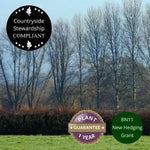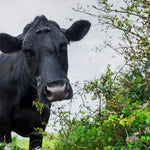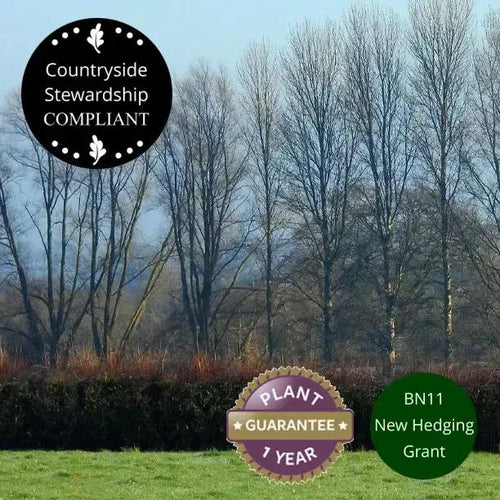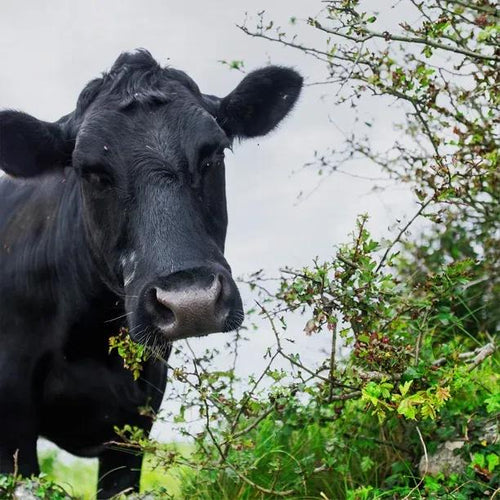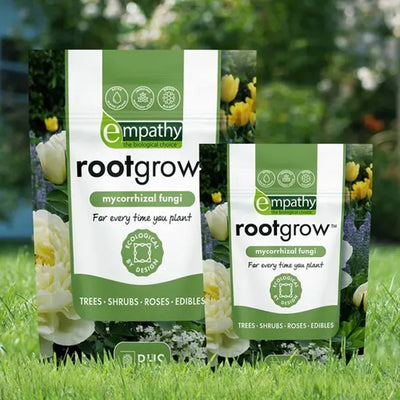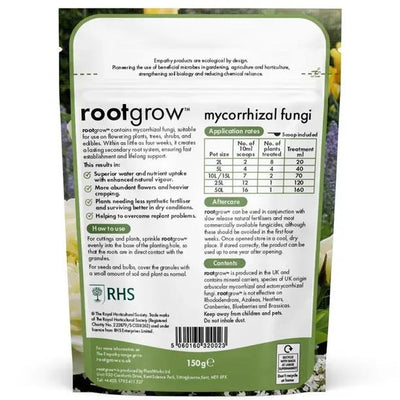Livestock Friendly Farm Hedge Plants
This mixed hedge pack is a bundle of 50 native Stock Proof plants, suitable for containing cattle, horses, and other livestock.
You can order the same plants individually from their respective pages, but you save money on the same size plants with the hedge pack.
We choose the plants that go into the hedge mix from the following list, and we cannot accept requests. If you want to be certain of having a particular plant in your hedge mix, please order it separately.
Features
- Native
- Qualifies for Countryside Stewardship grants (e.g. BN11: Planting New Hedges)
- 50% Hawthorn (25 per pack)
- 10% each of 5 plants, chosen by us from: Crab Apple, Dog Rose, Common Dogwood, Field Maple, Guelder Rose, Hazel, Sweet Briar Rose or Wayfaring Tree. (5 bundles of 5 per pack)
-
Contains no: Blackthorn, Privet, Spindle, or other inedible plants
- Each pack of 50 plants will make 16m of single row, or 8m of double row hedge.
Stock Friendly hedging mix is free from plants with long thorns, like blackthorn, that could scratch an animal's eye. The plants are all safe for farm animals to graze on, but overall the hedge will still be too thorny for most animals to eat. Like all newly planted hedging, it'll need to protect it from the animals for the first few years.
For our cheapest country hedging (may contain blackthorn), see our bundles of 250 small whips.
Stock Proof hedge packs are only delivered bareroot, during winter (November - March).
All our hedge plants are measured by their height in centimetres above the ground (the roots aren't measured).
See our selection of discounted hedging packs, or our full range of hedging plants.
Spacing a Stock Proof hedge:
Single row hedging at 3 plants per metre, 33cm apart, won't be truly stockproof by itself.
Stock proof, double row hedging is two single rows, 40cm apart, staggered into a W shape with 6 plants per metre. This qualifies for the BN11: Planting New Hedges Grant, and should stop a bull or stallion!
See our video on How to Plant a Country Hedge.
A hedge well maintained and protected, should be stock proof in five to six years, during which time you need a temporary fence or electric tape that is 2m away from the developing hedge. In addition, spirals and canes against rabbits and deer.
Horse & Cow Friendly Hedging
Large animals are close to our hearts as we are in Somerset and close to Dorset and Wiltshire - all counties full of them!
All choices of fencing have their drawbacks compared to hedging:
Features
- Post and rail: expensive, rots in the end, and horses chew wood for fun.
- Wire with a top layer of timber or plastic tubing to make it safe: also pricey and prone to rotting unless you spend even more money.
- Electric fencing is easy to move, but can fail without regular maintenance.
- Barbed wire: you want a nice hedge to cover it, so the animals can't reach it!
Horse-proof-and-safe hedging:
Features
- Keeps your horses and cattle contained.
- Shelters against wind and rain in winter, then sun and flies in summer.
- Is edible, safe to chew on.
It's also great for wildlife pollinators, looks lovely, and lasts for over a hundred years with a yearly maintenance trim.
Your cheapest option is simply Hawthorn, aka quickthorn, the backbone of most country hedging.
For more visual appeal, wildlife value and diverse nutrition for your horses, the mixed hedging on this page is ideal.
Where sheep are around with your horses and cows, wild roses are good to replace blackthorn, giving extra thorny bushiness at the base where sheep try to wriggle through.
A metre tall hedge is sufficient for ponies, two metres for most horses and stallions to be secure.
Make your own stock proof hedge recipe
Our prepacked bundles of 50 or 250 plants are always the most economical way to buy hedging.
To add plants to them yourself, or make your own from scratch, start with Hawthorn and make it at least 50% of the total.
Features
-
Do not use: Spindle, Privet, any of the Buckthorns, Holly, or Blackthorn. They may be fine for other livestock, but they're not recommended for equine hedges.
As well as the plants listed in the pack above, more classic choices:
Hornbeam, White Ramanas or Red Ramanas Rose,
Hedgerow trees for added interest and shade, try Willow, Mountain Ash, Silver Birch or Small Leaved Lime; buy them as whips (small plants) with your hedge, and mark them with a solid stake and tubular tree guard.
When you cut the rest of the hedge during the early first two years, leave these trees alone. When they reach about 2.5 metres, cut their tops off between November and the end of February, and they'll produce side branches.
For a belts and braces approach, plant either side of a post and rail fence.
Should I Use Horse Manure to Mulch My Hedge?
Fresh horse manure is too rich for young roots, so don't apply it. Well rotted horse manure, at least a year old, is a good organic mulch.
Cow, sheep, and goat manure is OK to use fresh, but it's still richer than you ideally need for newly transplanted hedging: compost is much better.
What trees are poisonous to horses?
To some degree, Sycamore, Acer pseudoplatanus, seeds and the acorns from Oak trees.
Sycamore seeds are associated with Atypical Myopathy in horses, but grazed in good pasture, horses ignore them.
Field Maple, Acer campestre, is in the same family as Sycamore and some people feel a little windy about including it in horse hedging, but as a hedge plant the foliage is fine to eat.
Oak tree acorns do not agree with horses, so if you have an existing Oak tree you can fence it off in autumn, rake them up when they fall.
Yew, Privet, and Laburnum are the most toxic while Box, Broom, Leylandii, Laurel, Rhododendron, and Spindle are pretty bad as well.
Blackthorn has large thorns that might hurt an eye or flank, especially when the stems grow long and whippy.

 Secure, One-Tap Checkout
Secure, One-Tap Checkout
 Hand Picked, Delivered to Your Door!
Hand Picked, Delivered to Your Door! 1 Year Bareroot Guarantee
1 Year Bareroot Guarantee